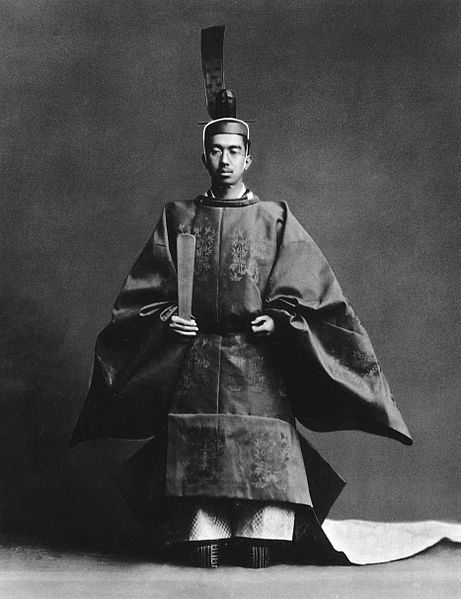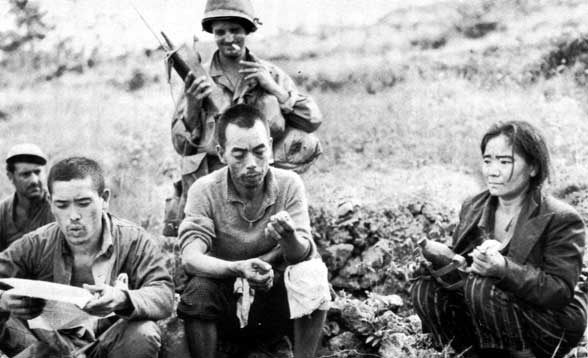The War of the Pacific against Imperial Japan was marked by episodes of mass suicides by Japanese soldiers and civilians, notably in Saipan and Okinawa. These deaths illustrated Japan’s will to fight to the death to defend their mainland rather than surrender unconditionally. They may also have played a role in the US military’s decision to drop the atomic bombs on Japan.
“They will not surrender”
In July 1944, American troops in Saipan bore witness to a “banzai” charge, where nearly 4,000 Japanese soldiers charged American troops and fought to their death. They were following the last orders of their commander, Lieutenant General Yoshisugu Saito, who had called for this all-out surprise attack in the honor of the Emperor before committing ritual suicide. American troops also witnessed a different atrocity as they saw women grabbing children and jumping from cliffs rather than submitting to capture.
As US forces pushed forward, island by island, troops continued to bear witness to Japanese soldiers and civilians taking their own lives. Okinawa was a particularly hellish scene as nearly one-third of the island population died. Among these were Koreans who had been forcibly migrated from annexed Korea to Japanese islands to be press-ganged as laborers and comfort women. While the Japanese government states there was “military involvement” in these suicides, survivors attest to a compulsory mass suicide, or shudan jiketsu.
Ota Masahide, a survivor and Okinawa historian, wrote in an article for the Asia-Pacific Journal in 2014 that the military distributed hand-grenades to the civilian population as the means to commit suicide with loved ones. Those that survived the grenades “worried” about being alive and found other ways to kill themselves with other weapons such as scythes, razor blades, ropes, rocks, and sticks. Military propaganda had warned the civilian population that if they were captured, the Americans would torture, rape, and murder them.
“As the mayhem unfolded, they found all sorts of ways to kill…Men bashed their wives and parents bashed their children, young people killed the elderly and the strong killed the weak,” Masahide said. “What they felt in common was the belief that they were doing this out of love and compassion.”
Another survivor, Kinjo Shigeaki, who took 20 years to speak about his experience, identified three factors that created this mentality: “The ideology of obedience to the Emperor, the presence of the Imperial Japanese Army, and being on an island…with no way to escape.”
“Back in those days of 100 million Japanese citizens supposedly being prepared to fight to the very last man, everybody was prepared for death,” Shigeaki said. “The doctrine of total obedience to the Emperor emphasized death and made light of life. The willingness to die for the Emperor on a faraway island resulted in a whole new sense of identity.”
Operation Ketsu-Go
In the meantime, “the Emperor on a faraway island” continued to call for suicidal defensive battle strategies. He hoped that the atrocities would persuade America to negotiate a compromise rather than an unconditional surrender, according to historian John W. Dower. Emperor Hirohito actively chose an “all-out defense of Okinawa” to showcase Japan’s willingness to fight to the end, ignoring advice to end the war.
As stories of Saipan and Okinawa reached the American public, the lasting effect was indeed a deep disturbance over the Japanese mindset as the public heard stories of kamikaze pilots plummeting to their deaths, and of mass suicides committed by members of the military and civilians.
“In ’45, we knew about Guadalcanal, we knew about Iwo Jima, we knew about Okinawa,” said Richard Yalman in an interview with the Atomic Heritage on 2015. “People are going to do kamikaze, every one of them is going to be a kamikaze. We knew that, and it would be just terrible.”

Raising of the Flag at Iwo Jima. Courtesy of Joe Rosenthal, Associated Press.
American military leadership was affected by the “ferocity of Japan’s no-surrender policy,” according to Dower. A Joint Chiefs of Staff planning document, dated August 30, 1944, coined the “Saipan ratio” and stated that it would take “approximately 1 American killed and several wounded to exterminate 7 Japanese soldiers.” According to the Saipan ratio, an invasion of the main island of Kyushu would be extremely costly in terms of American lives.
Then, on April 8, 1945, Japan launched Operation Ketsu-go. It was to be the final defense strategy in case of an American invasion of Kyushu and would focus on “inflicting tremendous casualties on US forces to undermine the American will to fight for unconditional surrender,” according to a publication by the Marine Corps Intelligence Activity (MCIA).
The mainland defense strategy called for an increase in the use of defensive suicide tactics. The remaining aircrafts were to be converted into kamikaze planes that would be released in “waves of 300-400, at the rate of one wave per hour against the invasion fleet,” according to the MCIA. The naval defense would include manned suicide torpedoes, suicide attack boats, and suicide divers.
Defense preparations would include mobilizing civilians, as the plan ordered all males 15 – 60 years old and all females 17 – 40 years old to be trained with hand grenades, swords, sickles, knives, fire hooks, and bamboo spears in preparation of joining the regular forces during night infiltration patrols.
Along with the military plans, Japanese leadership addressed the people directly and asked for the people to continue to fight. For example, in a special session of the Imperial Diet on June 9, 1945 Premier Kantaro Suzuki exalted the efforts at Okinawa and defended Japan’s “Holy War.”
“If the whole people will march forward with death-defying determination,” Suzuki said, “devoting their entire efforts to their own duties and to refreshing their fighting spirit, I believe that we will be able to overcome all difficulties.”
The controlled press continued the call to “die gloriously” in defense of the nation and began a daily “die for the emperor” campaign, states historian Herbert P. Bix. Or more sharply put, in the words of Dower, there was “increasingly hysterical rhetoric exhorting the ‘hundred million’ to die gloriously in defense of the nation and its emperor-centered ‘national polity.’”
The Emperor and the Imperial Way
Drawing upon the decades-old doctrine of the ineffable Imperial Way, the call to “die for the emperor” was evidently an effective tool in war propaganda. The myth of the Emperor and the Imperial Way had been carefully constructed, both from the feudalistic history of Japan and from the active policies of the royal family.
Growing up, Emperor Hirohito’s education propagated the tradition of the constructed emperor identity. He was taught “the Confucian model of the virtuous, peace-loving ruler and the Japanese bushido model of the ideal warrior,” explains Bix, who wrote the Pulitzer Prize-winning biography of Hirohito called Hirohito and the Making of Modern Japan. He also learned of the extent of the emperor’s power. For example, no laws or imperial ordinance could be made unless the emperor gave his assent first.
The emperor identity was also constructed through the media. Censorship laws in 1893, 1898, and 1900 prohibited critical writings on the emperor and strictly governed all publications. In this way, the royal family controlled the society’s perception of the Emperor as a god.

Emperor Hirohito at his coronation 1928
For example, the Commentaries on the Constitution of 1889 said, “The Emperor is Heaven descended, divine and sacred… He must be reverenced and is inviolable… the law has no power to hold him accountable.”
Along with this process, Japanese people constructed a new national identity called shinmin or “loyal subjects” as Japan began to grow in political, economic and military power. From a young age, Japanese children were taught that they were the subjects of the emperor and had to obey him just as they obeyed their parents, notes Bix.
In the 1890 Imperial Rescript on Education, shinmin translated as “loyal officials directly sub-ordinated to the emperor” and “people who obediently comply with their orders.” The Rescript also listed Confucian virtues and stated, “Should emergency arise, offer yourselves courageously to the State; and thus guard and maintain the prosperity of Our Imperial Throne coeval with heaven and earth.”
This was the ideology that Emperor Hirohito called upon: Not a new edict to fight to the death for Japan and the Emperor, but an invocation to the culture of the emperor, which had been instilled in the Japanese people.
This ideology may not fully provide an explanation to why thousands committed suicide in the name of the Emperor. In Okinawa, historians and survivors state it was ordered by the military. For the military officers, they may have been following the bushido warrior code, which says that one must die rather than surrender. Dower explains foreigners often accept the mythology that the Japanese unanimously embraced death out of devotion to the Emperor and the Imperial Way.
Historian Nancy Bartlit said in an interview with the Atomic Heritage Foundation in 2013, “This is so complicated, but it is the opposite of what we think of. We try to preserve a life. We try to save life. We in the West would give our life for our buddy. We will give our life for our country. What is different from the kamikaze who will give his life for the Emperor? There are differences, but I raise that for the student to examine and look at the different values.”
Students and historians will undoubtedly continue to examine and debate the Japanese mass suicides.





